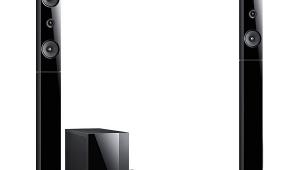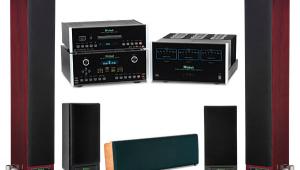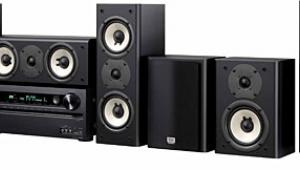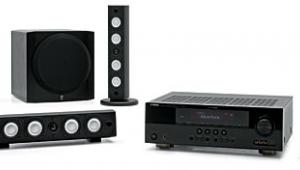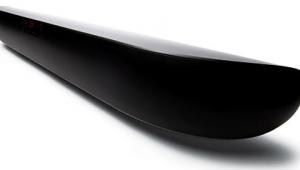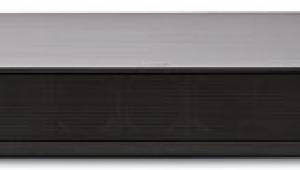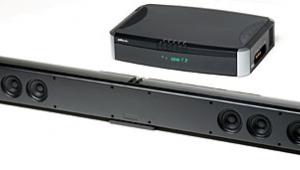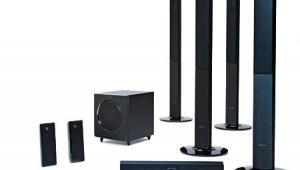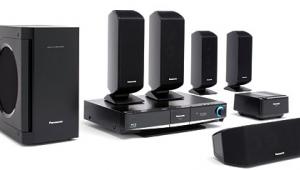Harman/Kardon CP 35 Home Theater System
Let's see. The CP 35 features a DVD player, receiver, and 7.1-channel speaker system that arrives packaged in one box. Around these parts, we'd call that a home-theater-in-a-box, but Harman/Kardon has wisely chosen the descriptor "home theater system" instead. I say "wisely" because the HTIB moniker brings with it certain expectations (for better and for worse), and Harman/Kardon doesn't want to confuse us reviewer types by forcing us to realign our expectations when evaluating this system. How thoughtful.
Upgradeability vs. Easy Setup
The current trend in HTIBs is to combine the DVD player and receiver into one chassis. It looks sleeker, and it's usually easier to set up, especially when you add fixed crossovers and proprietary speaker connectors that snap into place. It's a nifty setup. . .until something breaks or you're ready to upgrade, which you often can't do without purchasing an entirely new system.
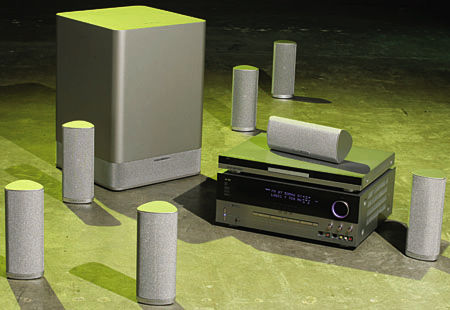
The CP 35 isn't a built-from-scratch HTIB in which each piece is designed specifically to work with the others. Rather, it's four distinct Harman/Kardon products—the AVR 335 7.1-channel receiver, the DVD 31 DVD-Audio/-Video player, the HKTS 14 5.1-channel speaker system, and the matching HKS 4 speaker two-pack—packaged in one box, with a $50 price break for buying the sum instead of the parts. Basically, it's the company's way of taking the guesswork out of picking your gear. Inside that big carton are four components with four owner's manuals, plus lots of cables and wall-mounting brackets. The sight of it is really quite daunting.
Once you get over the shock, initial setup isn't too difficult. Two items unite the individual pieces to form a system: the Quick-Start Guide quick-setup reference and the RCP 2 universal remote, which is preprogrammed to control the receiver and DVD player. The small, silver speakers have built-in bases, so there's no assembly required unless you want to wall-mount them. All of the speaker wire and A/V cables are color-coded, and Harman/Kardon supplies several sheets of labels to affix to the various connections to make future connects and disconnects easier.
The easy-to-follow Quick-Start Guide will move you fairly quickly through the process of configuring and placing your speakers, connecting your sources and TV to the receiver, and using the automatic-calibration system to set up the receiver. To set up the DVD player and fine-tune the system, it's off to the owner's manuals you must go. The manuals are thorough, but they're not clearly laid out: Each section runs into the next without obvious delineations, and I found them frustrating to read through. My primary ergonomic gripe about the AVR 335 receiver is that the onscreen menu isn't visible from the component video output, and the ability to change settings using the front-panel display is limited, so you have to make an S-video or composite connection to your display to see the menu.
The DVD 31's onscreen menu lacks an initial-setup option that lets you make important selections like TV shape and progressive or interlaced output, but it was pretty easy to maneuver to these parameters in the general setup menu—once I figured out that the OSD button on the RCP 2 remote serves as the setup button when it's in DVD mode. A lot of the remote's buttons pull double-duty, so you should read through the RCP 2 manual before you get started (that makes five manuals, if you're counting). In doing so, you'll learn how to program the remote so that the volume control works when you're in DVD (or any other) mode—something I think Harman/Kardon should've preprogrammed themselves. Also, only the remote's source buttons are backlit, which makes it all the more challenging to figure out which button controls which function in which mode.
Control vs. Simplicity
The CP 35 isn't intended for the average HTIB buyer who wants to perform a basic setup and then go about the business of A/V enjoyment. This is a step-up system for someone who wants more control over their A/V signals, and both the receiver and the DVD player provide plenty of ways to tailor the sound and picture. The AVR 335 has a ton of processing modes, including Dolby Digital EX, Pro Logic IIx, and Dolby Headphone. DTS ES (Matrix and Discrete) and Neo:6 are also included, as well as Harman's proprietary Logic 7 mode, sporting a new seven-channel implementation. One feature that proved to be highly valuable in my case (which I'll discuss shortly) is the AVR 335's quadruple crossover, which lets you select a different crossover point for the front, center, surround, and rear channels.
 As I mentioned above, the AVR 335 also features Harman/ Kardon's EzSet+ auto-calibration system, and it is indeed easy to set. Just plug the supplied microphone into the front-panel headphone jack, select EzSet+ from the onscreen menu, tell it whether you have a 5.1 or 7.1 system, and hit the remote's Set button. The receiver automatically determines each speaker's size, distance, level, and crossover. I used all of the speakers to create a 7.1-channel system, but you could use the HKTS 14 for a 5.1 setup and the HKS 4 two-pack to feed stereo audio to a second room; the AVR 335 even comes with a zone-two remote.
As I mentioned above, the AVR 335 also features Harman/ Kardon's EzSet+ auto-calibration system, and it is indeed easy to set. Just plug the supplied microphone into the front-panel headphone jack, select EzSet+ from the onscreen menu, tell it whether you have a 5.1 or 7.1 system, and hit the remote's Set button. The receiver automatically determines each speaker's size, distance, level, and crossover. I used all of the speakers to create a 7.1-channel system, but you could use the HKTS 14 for a 5.1 setup and the HKS 4 two-pack to feed stereo audio to a second room; the AVR 335 even comes with a zone-two remote.
With my 7.1 setup, EzSet+ did a good job determining each speaker's size and distance, but it set the crossovers between 150 and 200 hertz. I thought this would put too much burden on the subwoofer, so I lowered the crossover point to 120 Hz for all of the speakers. I also tested the EzSet+ results with an SPL meter and found the speaker levels to be a couple of decibels off, while the sub level was much higher than everything else. Manually matching the levels almost exactly wasn't a problem, although I'd later discover that maybe it wasn't a mistake to set the subwoofer level so high. (That's what we call a teaser.)
While EzSet+ will test and configure all seven speakers when you first set up the AVR 335, if you later wish to alter your speaker settings, you have to put a Dolby Digital EX or DTS ES disc into your DVD player; the receiver needs to sense a seven-channel source to grant you access to all seven speakers. That's unfortunate. On a brighter note, the AVR 335 automatically senses a Dolby Digital or DTS source and switches to the correct processing mode, which isn't always the case in the receiver world.
The DVD 31 includes adjustments for the picture's color saturation, tint, contrast, brightness, and black level, as well as auto, film, and video processing modes for a progressive-scan component video signal. The DVD 31 is also a DVD-Audio player with one set of 5.1-channel analog audio outputs, and the setup menu includes bass management to select each speaker's size, distance, and level. Why Harman/Kardon went that far down the bass-management path but chose not to include internal test tones to set the speaker level is a mystery.Performance vs. Price
The DVD 31 is a solid performer. It never locked up on me, and it responded quickly to the RCP 2's commands. Its video resolution was solid but not outstanding. There was a gradual rolloff throughout the whole frequency range with both interlaced and progressive component video signals. Avia Pro's 6.75-megahertz circle revealed clear banding, so the player can't resolve the finest details in a DVD signal, although I didn't feel I was missing any detail with real-world material.
The auto processing mode gave the Video Essentials Snell & Wilcox Zone Plate test some trouble (it never picked up the 3:2 film sequence), but it seemed to do a fine job with test scenes from Gladiator and The Bourne Identity. When I switched to film mode, the player did a much better job picking up the Snell & Wilcox 3:2 film sequence. Neither the auto nor the video mode did a great job with video sources, creating a lot of artifacts with both test-disc and real-world material, although the video mode performed slightly better.
As for the HKTS 14/HKS 4 speaker system, it provided quite a challenge. I had to experiment with several placement and crossover options before I found a sound that satisfied me. With the speakers at ear level (while seated) and a 120-Hz crossover setting, the sound was small and somewhat dull. The subwoofer did a solid job with stereo music; bass wasn't boomy, but it wasn't as cleanly defined as I prefer. When I switched to film soundtracks, the sub barely put out any low-end info when I matched its level to that of the satellites. Apparently, EzSet+ knew what it was doing because I had to turn up the sub's level a good deal (but nowhere near its maximum setting) to flesh out the low end. That didn't help the poor, tiny center channel, which was still being asked to do more than it could handle.
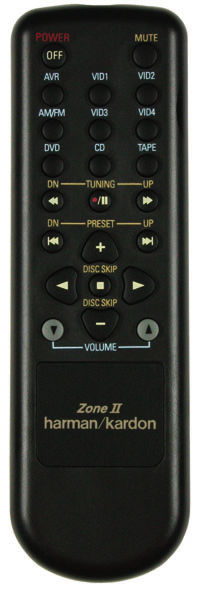 When I raised the speakers above ear level (30 inches for the center, 37 for the front left and right, and 40 for the surrounds), the sound definitely grew bigger and livelier. I could fill the room with music, even in stereo mode, but I liked the warmth and envelopment that the Logic 7 seven-channel music mode provided. I preferred it to DPLIIx. Still, I felt like the sub and sats just weren't blending properly to reproduce movie and multichannel music soundtracks. I tried 100- and 150-Hz crossover settings and even moved one of the vertically oriented rear channels to the center position, but the AVR 335 doesn't allow for a 6.1 setup, so I had to go down to 5.1 and lose a speaker. None of these configurations did the trick.
When I raised the speakers above ear level (30 inches for the center, 37 for the front left and right, and 40 for the surrounds), the sound definitely grew bigger and livelier. I could fill the room with music, even in stereo mode, but I liked the warmth and envelopment that the Logic 7 seven-channel music mode provided. I preferred it to DPLIIx. Still, I felt like the sub and sats just weren't blending properly to reproduce movie and multichannel music soundtracks. I tried 100- and 150-Hz crossover settings and even moved one of the vertically oriented rear channels to the center position, but the AVR 335 doesn't allow for a 6.1 setup, so I had to go down to 5.1 and lose a speaker. None of these configurations did the trick.
Then I remembered that nice quadruple crossover. I set the front and surround speakers at 120 Hz and eased the center channel's load by setting it at 150 Hz, positioning the sub very close to the center channel to make sure the front soundstage remained cohesive. This proved to be the one; it created a better, but not perfect, blend between the bass, mids, and highs and produced a fuller, more convincing presentation overall. Whew, that's a lot more work than a beginner will put into configuring his or her speakers—good thing this isn't an HTIB. The fact that I had so many configuration options at my disposal distinguishes this system from an HTIB.
Because the CP 35 is made up of individual components, its price is higher than what you'll usually see in the HTIB realm. In the long run, though, the ability to upgrade, as opposed to buying a whole new system, might actually save you money. I recommend that the center channel be first on your upgrade list. It's just too small to do everything that a movie soundtrack asks of it.
HTIBs are fine for the average consumer who loves a home theater's coolness factor but fears its technical factor. For the blossoming A/V enthusiast, a prepackaged home theater system like the CP 35 provides enough user-friendly features to get you started and enough advanced functionality to keep you moving ahead.
Highlights
• The receiver has plenty of processing modes, plus a quadruple crossover system
• Enjoy a 7.1-channel system or a 5.1 system with stereo playback in a second zone
